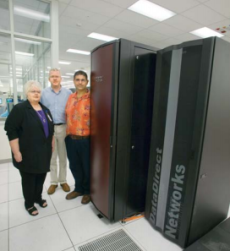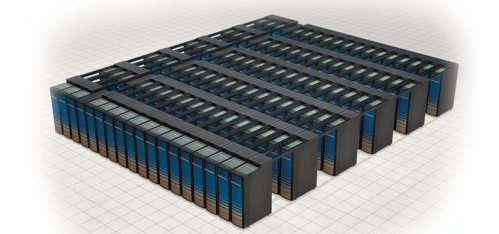First Cabinet of NERSC’s New Cray Supercomputer Arrives for Testing
September 1, 2006

Lynn Rippe, Jonathan Carter and Nick Cardo of the NERSC procurement team welcome the first cabinet of the new Cray supercomputer and the attached disk storage from Data Direct Networks.
Within weeks of the announcement that NERSC’s next large system will be a follow-on to the Cray XT3 supercomputer, the first cabinet of the new machine has been installed for testing at Berkeley Lab’s Oakland Scientific Facility.
The new supercomputer, which will be among the world’s fastest general purpose system, will have a guaranteed sustained performance of at least 16 trillion calculations per second (with a theoretical peak speed of 100 trillion calculations per second) when running a suite of diverse scientific applications at scale.
Cray will begin shipping the newsupercomputer to the NERSC facility at the Lawrence Berkeley National Laboratory later this year, with Complete installation is expected in the first half of 2007 and acceptance in mid-2007.
As part of a competitive procurement process, NERSC evaluated systems from a number of vendors using the Sustained System Performance (SSP) metric. The SSP metric, developed by NERSC, measures sustained performance on a set of codes designed to accurately represent the challenging computing environment at the Center.
“While the theoretical peak speed of supercomputers may be good for bragging rights, it’s not an accurate indicator of how the machine will perform when running actual research codes,” said Horst Simon, director of the NERSC Division at Berkeley Lab. “To better gauge how well a system will meet the needs of our 2,500 users, we developed SSP. According to this test, the new system will deliver over 16 teraflops on a sustained basis.”

Artist’s rendering of NERSC’s new Cray Supercomputer.
The Cray supercomputer at NERSC will consist of over 19,000 AMD Opteron 2.6-gigahertz processor cores, with two cores per socket making up one node. Each node has 4 gigabytes (4 billion bytes) of memory and a dedicated SeaStar connection to the internal network. The full system will consist of over 100 cabinets with 39 terabytes (39 trillion bytes) of aggregate memory capacity.
In keeping with NERSC’s tradition of naming supercomputers after world-class scientists, the new system will be called “Franklin” in honor of Benjamin Franklin, America’s first scientist. This year is the 300th anniversary of Franklin’s birth.
“Ben Franklin’s scientific achievements included fundamental advances in electricity, thermodynamics, energy efficiency, material science, geophysics, climate, ocean currents, weather, population growth, medicine and health, and many other areas,” said NERSC General Manager Bill Kramer. “In the tradition of Franklin, we expect this system to make contributions to science of the same high order.”
The new computer and a multi-year services contract are valued at over $52 million. The contract also provides options for future upgrades that would quadruple the size of the system and eventually boost performance to one petaflops (1,000 trillion floating point operations per second) and beyond.
About NERSC and Berkeley Lab
The National Energy Research Scientific Computing Center (NERSC) is a U.S. Department of Energy Office of Science User Facility that serves as the primary high performance computing center for scientific research sponsored by the Office of Science. Located at Lawrence Berkeley National Laboratory, NERSC serves almost 10,000 scientists at national laboratories and universities researching a wide range of problems in climate, fusion energy, materials science, physics, chemistry, computational biology, and other disciplines. Berkeley Lab is a DOE national laboratory located in Berkeley, California. It conducts unclassified scientific research and is managed by the University of California for the U.S. Department of Energy. »Learn more about computing sciences at Berkeley Lab.







